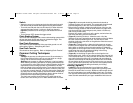
14
Bucking
Bucking is cutting a felled tree or log into lengths. How you should
cut depends on how the log is supported. Use a saw horse
(figure W) whenever possible.
Always start a cut with the chain running at full speed and the
ribbed bumper (7) in contact with the wood. To complete the cut
use a pivoting action of the ribbed bumper against the wood.
• (Figure S) When supported along its whole length
Make a cut from the top (overbuck), but avoid cutting the earth as
this will dull your saw quickly.
• (Figure T) When supported at one end
First, cut 1/3 the diameter from the underside (underbuck). Then
make the finished cut by overbucking to meet the first cut.
• (Figure U) When supported at both ends
First, cut 1/3 down from the top overbuck. Then make the finished
cut by underbucking the lower 2/3 to meet the first cut.
• (Figure V) When on a slope
Always stand on the uphill side of the log. When "cutting through",
to maintain complete control release the cutting pressure near the
end of the cut without relaxing your grip on the chain saw handles.
Don't let the chain contact the ground. After completing the cut, wait
for the saw chain to stop before you move the chain saw. Always
stop the motor before moving from tree to tree.
• (Figure W) When using a saw horse
This is strongly recommended whenever possible. Position the log
in a stable position. Always cut on the outside of the saw horse arms.
Care and Maintenance
Use only mild soap and damp cloth to clean the tool. Do not use
solvents to clean the plastic housing of the saw. Never let any liquid
get inside the tool; never immerse any part of the tool into a liquid.
IMPORTANT: To assure product SAFETY and RELIABILITY, repairs,
maintenance and adjustment should be performed by authorized
service centers or other qualified service organizations, always using
identical replacement parts.
Regular maintenance ensures a long effective life for your chain
saw. We recommend you make the following checks on a regular
basis:
Oil Level
The level in the reservoir should not be allowed to fall below a
quarter full.
Chain and Bar
After every few hours of use, remove the guide bar and chain and
clean thoroughly.
Saw Chain Sharpening
CAUTION: Sharp chain. Always wear protective gloves when
handling the chain. The chain is sharp and can cut you when it is
not running.
WARNING: Sharp moving chain. To prevent accidental
operation, insure that battery is disconnected from the tool
before performing the following operations. Failure to do this
could result in serious personal injury.
To get the best possible performance from your chain saw it is
important to keep the teeth of the chain sharp. Follow these helpful
tips for proper saw chain sharpening:
1. For best results use a 4.5mm file and a file holder or filing guide
to sharpen your chain. This will ensure you always get the correct
sharpening angles.
2. Place the file holder flat on the top plate and depth gauge of the
cutter.
3. (Figure X) Keep the correct top plate
(24) filing angle line of 30° on your file
guide parallel with your chain (file at 60°
from chain viewed from above).
4. (Figure Y) Sharpen cutters (25) on one
side of the chain first. File from the inside
of each cutter to the outside. Then turn
your saw around and repeat the processes (2,3,4) for cutters on
the other side of the chain. Use a flat file to file the tops of the
rakers (portion of chain link in front of the cutter) so that they are
about .025 inch (.635 mm) below the tips of the cutters.
24
24
90560838 ccs818 chain saw.qxd: chainsaw booklet new 2/12/10 10:07 AM Page 14


















